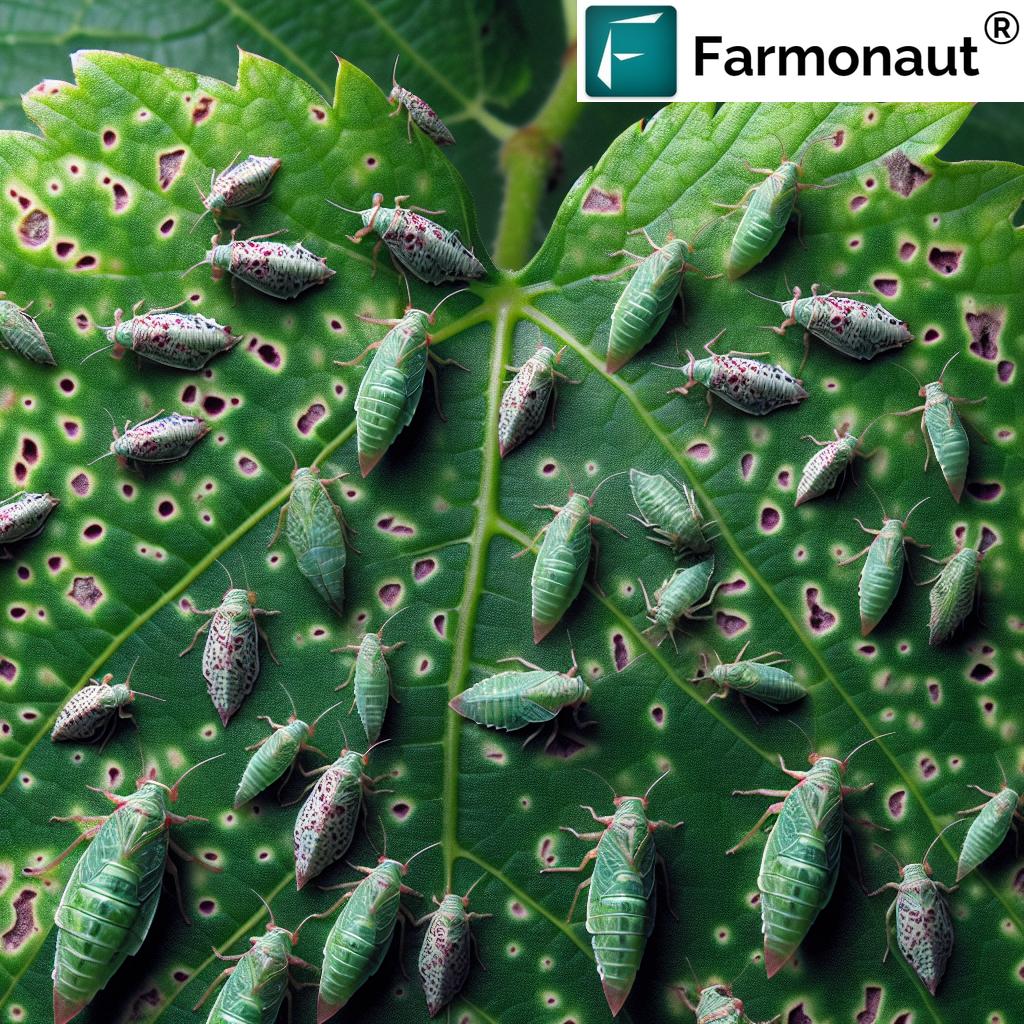Grape Leafhopper Control: Protecting Your Vineyard from Bud Break to Harvest

As vineyard managers and grape growers, we understand the critical importance of protecting our vines from various pests and diseases. Among these, grape leafhoppers stand out as a particularly troublesome insect that can significantly impact the health and productivity of our vineyards. In this comprehensive guide, we’ll explore the world of grape leafhoppers, their impact on vineyards, and the most effective control strategies to safeguard your grape crops from bud break to harvest.
Understanding Grape Leafhoppers
Grape leafhoppers (Erythroneura spp.) are small, wedge-shaped insects that pose a significant threat to vineyards worldwide. These pests are known for their ability to pierce and feed on grape leaves, causing damage that can lead to reduced yield and quality of grapes.
Species and Identification
There are several species of leafhoppers that affect grapevines, including:
- Western grape leafhopper (Erythroneura elegantula)
- Eastern grape leafhopper (Erythroneura comes)
- Variegated leafhopper (Erythroneura variabilis)
Identifying these species is crucial for implementing effective control measures. Adult leafhoppers are typically about 3mm long and can vary in color from pale yellow to light green, often with distinctive markings on their wings.
Life Cycle and Behavior
Understanding the life cycle of grape leafhoppers is essential for effective management:
- Overwintering: Adults survive winter in leaf litter or bark crevices.
- Spring Emergence: As temperatures warm, adults emerge and begin feeding on new foliage.
- Egg-laying: Females lay eggs within the leaf tissue of grapevines.
- Nymph Development: Nymphs hatch and go through five instars, feeding on leaves.
- Adult Stage: New adults emerge and continue the cycle, with multiple generations per season.
Impact on Vineyards
Grape leafhoppers can have a significant impact on vineyard health and productivity:
Leaf Damage
Both nymphs and adults feed by piercing leaf cells and extracting their contents. This feeding activity results in:
- Stippling or chlorotic spots on leaves
- Reduced photosynthetic capacity
- Premature leaf drop in severe cases
Yield and Quality Reduction
The cumulative effect of leafhopper feeding can lead to:
- Decreased sugar content in grapes
- Reduced fruit size and cluster weight
- Increased susceptibility to sunburn and other quality issues
Disease Transmission
Some leafhopper species can vector plant pathogens, potentially spreading diseases throughout the vineyard.
Monitoring and Detection
Effective leafhopper control begins with vigilant monitoring. Traditional methods include:
- Visual inspection of leaves for stippling and presence of nymphs or adults
- Yellow sticky traps to capture adult leafhoppers
- Leaf sampling to count nymphs
However, modern technology offers more efficient solutions. At Farmonaut, we’ve developed advanced satellite-based monitoring systems that can detect early signs of leafhopper infestation across large vineyard areas.
| Method | Accuracy | Coverage Area | Frequency | Cost-effectiveness |
|---|---|---|---|---|
| Traditional Visual Inspection | Moderate | Small | Weekly | Low |
| Yellow Sticky Traps | Moderate | Small | Weekly | Moderate |
| Leaf Sampling | High | Small | Weekly | Low |
| Farmonaut Satellite-Based Detection | High | Large | Daily | High |
Our satellite-based system offers several advantages:
- Early detection of stress patterns indicative of leafhopper activity
- Comprehensive coverage of large vineyard areas
- Frequent updates allowing for timely intervention
- Integration with our AI-powered advisory system for targeted management recommendations
To learn more about our satellite-based monitoring system, visit Farmonaut’s App.
Control Strategies
Effective leafhopper control requires an integrated approach, combining cultural, biological, and chemical methods as needed.
Cultural Control
- Vineyard Sanitation: Remove leaf litter and prune properly to reduce overwintering sites.
- Cover Crops: Maintain diverse ground cover to support natural predators.
- Dust Management: Minimize dust on vines, as dusty conditions favor leafhopper populations.
Biological Control
Encouraging natural enemies can help keep leafhopper populations in check:
- Parasitic wasps (e.g., Anagrus spp.)
- Predatory insects like ladybugs and lacewings
- Spiders and other generalist predators
Chemical Control
When populations exceed economic thresholds, chemical interventions may be necessary:
- Insecticidal soaps and oils for organic production
- Systemic insecticides for severe infestations
- Targeted sprays based on monitoring data to minimize environmental impact
It’s crucial to rotate chemical classes to prevent resistance development.
Seasonal Management: From Bud Break to Harvest
Effective leafhopper management requires a season-long approach:
Spring (Bud Break to Bloom)
- Monitor for overwintering adults as they emerge
- Implement early-season cultural controls
- Consider preventive measures if historical pressure is high
Summer (Fruit Set to Veraison)
- Intensify monitoring efforts as populations build
- Implement biological controls
- Apply targeted chemical controls if thresholds are exceeded
Late Summer to Harvest
- Continue monitoring, focusing on fruit quality impacts
- Manage late-season populations to prevent harvest issues
- Plan post-harvest strategies to reduce overwintering populations

Leveraging Technology for Leafhopper Management
At Farmonaut, we’re committed to bringing cutting-edge technology to vineyard management. Our satellite-based monitoring system, combined with AI-powered analytics, offers vineyard managers powerful tools for leafhopper control:
- Early Detection: Our satellite imagery can detect subtle changes in leaf reflectance patterns indicative of leafhopper feeding before visible damage occurs.
- Precision Mapping: We generate detailed maps of infestation hotspots, allowing for targeted interventions.
- Predictive Analytics: Our AI models use historical data and current conditions to forecast potential leafhopper outbreaks.
- Integrated Management: Our platform integrates with weather data and other vineyard management tools for comprehensive pest management.
To explore how our technology can revolutionize your leafhopper management strategy, visit our API documentation or download our mobile app for Android or iOS.
Case Studies: Successful Leafhopper Management
While we don’t include specific case studies, our technology has helped numerous vineyard managers across different regions improve their leafhopper management strategies. Common outcomes include:
- Reduction in overall pesticide use through targeted applications
- Improved grape quality and yield due to early intervention
- Cost savings from more efficient resource allocation
- Enhanced sustainability practices aligning with market demands
Future Trends in Leafhopper Control
As we look to the future of vineyard pest management, several exciting trends are emerging:
- Advanced Phenotyping: Using hyperspectral imaging to detect plant stress responses to leafhopper feeding at a molecular level.
- Precision Agriculture: Integrating drone technology with our satellite data for even more detailed monitoring.
- Biocontrol Innovations: Developing new strains of beneficial organisms specifically targeted at grape leafhoppers.
- Climate-Adaptive Strategies: Using our AI models to predict and adapt to changing leafhopper behavior due to climate change.
Sustainable Practices and Leafhopper Control
At Farmonaut, we’re committed to promoting sustainable vineyard management practices. Our approach to leafhopper control aligns with this commitment:
- Reduced Chemical Use: By providing precise monitoring data, we help minimize unnecessary pesticide applications.
- Ecosystem Preservation: Our holistic approach encourages biodiversity and natural pest control mechanisms.
- Water Conservation: Efficient pest management leads to healthier vines that use water more effectively.
- Carbon Footprint Reduction: Optimized vineyard operations, including pest management, contribute to overall carbon footprint reduction.
For more information on how our technology supports sustainable vineyard practices, check out our developer documentation.
Economic Impact of Effective Leafhopper Management
Implementing a comprehensive leafhopper management strategy can have significant economic benefits for vineyard operations:
- Increased Yield: Healthy vines produce more high-quality grapes.
- Quality Premium: Better fruit quality can command higher prices in the market.
- Reduced Input Costs: Targeted interventions lead to more efficient use of resources.
- Long-term Vineyard Health: Consistent management preserves vine longevity and productivity.
Our technology helps quantify these benefits, allowing vineyard managers to make data-driven decisions that positively impact their bottom line.
Regulatory Considerations in Leafhopper Control
When developing a leafhopper management strategy, it’s crucial to consider regulatory requirements:
- Pesticide Regulations: Ensure all chemical controls are approved for use in your region.
- Organic Certification: For organic vineyards, verify that control methods meet certification standards.
- Export Requirements: Be aware of pesticide residue limits for international markets.
- Environmental Protection: Adhere to local regulations regarding wildlife and water quality protection.
Our platform helps keep you informed about these regulatory aspects, ensuring your leafhopper control measures are both effective and compliant.
Training and Education for Effective Leafhopper Management
At Farmonaut, we believe that empowering vineyard teams with knowledge is key to successful pest management. We offer various resources to support your leafhopper control efforts:
- Online Courses: Comprehensive training on leafhopper biology, monitoring techniques, and control strategies.
- Webinars: Regular updates on the latest research and technology in vineyard pest management.
- In-Field Workshops: Hands-on training sessions for practical implementation of monitoring and control techniques.
- Decision Support Tools: Interactive guides within our app to help interpret data and make management decisions.
Collaborative Research Initiatives
We actively collaborate with research institutions and industry partners to advance leafhopper management techniques:
- Participating in field trials to validate new control methods
- Sharing anonymized data to support broader research efforts
- Developing machine learning models to improve early detection accuracy
- Exploring novel biocontrol agents specific to grape leafhoppers
These collaborations ensure that our technology remains at the forefront of vineyard pest management innovation.
Integrating Leafhopper Management with Overall Vineyard Health
Effective leafhopper control is just one aspect of maintaining healthy, productive vineyards. Our holistic approach considers how leafhopper management interacts with other vineyard practices:
- Nutrient Management: Balancing vine nutrition to promote natural resistance to pests
- Irrigation Strategies: Optimizing water use to maintain vine health without creating favorable conditions for leafhoppers
- Canopy Management: Adjusting pruning and trellising practices to reduce leafhopper habitat while maintaining fruit quality
- Soil Health: Promoting beneficial soil microorganisms that can indirectly support pest resistance
Our platform integrates data from these various aspects of vineyard management, providing a comprehensive view of vineyard health and productivity.
Community and Industry Engagement
We recognize the importance of community and industry involvement in successful pest management:
- Grower Networks: Facilitating knowledge sharing among vineyard managers facing similar leafhopper challenges
- Industry Partnerships: Collaborating with equipment manufacturers and input suppliers to develop integrated solutions
- Policy Advocacy: Engaging with regulatory bodies to ensure policies support sustainable pest management practices
- Public Education: Promoting understanding of sustainable vineyard practices among consumers and the broader community
Conclusion
Effective grape leafhopper control is essential for maintaining healthy, productive vineyards. By combining traditional knowledge with cutting-edge technology, we can develop comprehensive management strategies that protect our vines from bud break to harvest. At Farmonaut, we’re committed to providing vineyard managers with the tools and insights needed to tackle this persistent pest while promoting sustainable, efficient vineyard operations.
Remember, successful leafhopper management is an ongoing process that requires vigilance, adaptability, and a willingness to embrace new technologies and techniques. By staying informed, leveraging advanced monitoring tools, and implementing integrated management strategies, we can ensure the long-term health and productivity of our vineyards.
FAQs
-
Q: How can I tell if my vineyard has a leafhopper infestation?
A: Look for stippling or small white spots on leaves, especially on the undersides. You may also see small, wedge-shaped insects jumping when disturbed. Our satellite monitoring can detect early signs of stress before visible damage occurs.
-
Q: Are all leafhopper species equally harmful to grapevines?
A: While several species can damage grapevines, some are more problematic than others. The Western grape leafhopper and variegated leafhopper are often considered the most economically significant in many regions.
-
Q: How often should I monitor for leafhoppers?
A: Traditional methods recommend weekly monitoring during the growing season. However, our satellite-based system provides daily updates, allowing for more timely interventions.
-
Q: Can organic vineyards effectively control leafhoppers?
A: Yes, organic vineyards can use a combination of cultural practices, biological controls, and approved organic pesticides to manage leafhopper populations effectively.
-
Q: How does climate change affect leafhopper populations?
A: Warmer temperatures can lead to earlier emergence and more generations per season. Our predictive models take climate data into account to help you adapt your management strategies.
